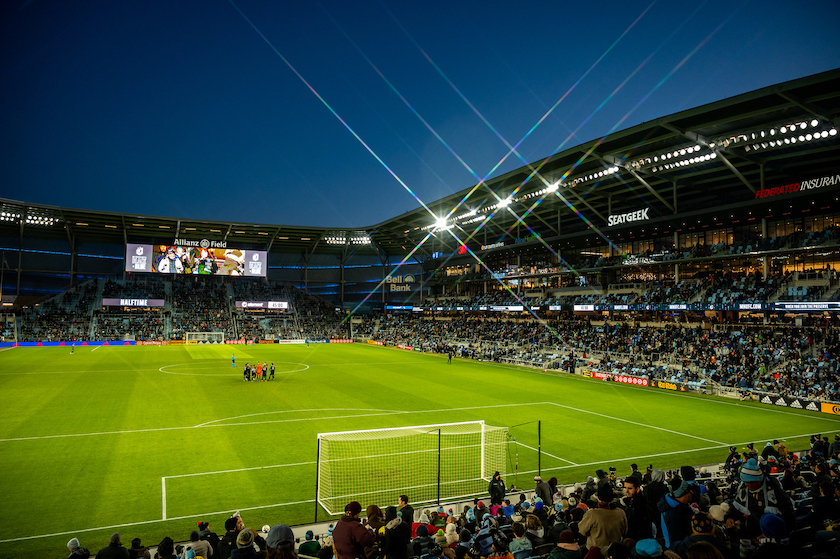MNUFC 1, Orlando City 2: The tactical change that changed the Loons' fate

Through 55 minutes, Minnesota United’s 2-1 loss against Orlando City looked like it would be another in a series of tight, cagey defensive performances by the Loons.
Orlando had yet to create anything that looked like a scoring chance. The Loons weren’t much more dangerous.
Ten minutes into the second half, though, Minnesota made a change that, finally, unlocked their own offense - but in the process, gave the Lions the space that they needed to steal three points.
The Loons started the game with their by-now-familiar 4-2-3-1 offensive setup, but with Sang Bin Jeong making his first start. Jeong was placed in the center of the attack, in the attacking midfield role, operating just behind Mender García and in between Bongokuhle Hlongwane (out left) and Robin Lod (out right).
Out of this setup, the two inverted wingers drift towards the middle, and the fullbacks provide width by overlapping. The two midfielders, in this case Kervin Arriaga and Hassani Dotson, look to either push the ball out wide to these overlaps, or find that central midfielder to create chances from the center.
Jeong, however, had two things working against him in this setup. For one, he hadn’t played more than 30 minutes in a game since October 15. Approaching the end of the first half, and again at the start of the second, he was pretty clearly already out of gas.
Second, he might be in the number 10 role, but asking anyone to step into that role and immediately be able to combine with teammates and find a rhythm is a big ask. Jeong wasn’t coming back to find the ball, and when he did, he wasn’t carrying it forward or making progressive passes. Putting him immediately in the center of the attack might not have been setting him up to succeed.
And so after 56 minutes, the Loons made the switch, bringing in Wil Trapp as a defensive midfielder and pushing Hassani Dotson into the number-10 role. Almost immediately, it paid dividends; Dotson charged forward, Lod broke the lines with a pass, and Dotson turned the ball back to Hlongwane, who’d beat his defender to the front of goal. It was Minnesota’s best goal of the season, certainly the only one that looked like they’d planned it, from an attacking standpoint.
At the same time, though, the change - and perhaps the goal - led to a change in Minnesota’s defensive structure.
Minnesota often defends with a 4-4-2 structure, with the center forward and the number 10 as a two-man soft press. Rarely do you see the whole team surging forward to try to cause a defensive mistake. The two wings will occasionally attempt to harry an opposing fullback, but they’re also responsible for dropping back and helping to provide cover down the flanks, while the two defensive midfielders stay in the middle of the field.
Against Orlando, which played with three defenders and two wingbacks, this meant that Robin Lod and Bongokuhle Hlongwane were often responsible for tracking back and being responsible for those two wingbacks, especially given how high Orlando wanted to push them.
You saw this a lot in the first half, Lod and Hlongwane providing that cover down the flanks, with fullbacks DJ Taylor and Kemar Lawrence staying in the back line.
After the substitution, though, Minnesota changed that setup so that only the center forward was high in the press, and the three midfielders - Trapp, Dotson, and Arriaga - formed an upside-down triangle, with Trapp as a defensive midfielder at the base, and Dotson and Arriaga ahead. Instead of a 4-4-2, it was more of a 4-1-4-1.
In practice, what this meant is that the three midfielders were trying to cover the width of the field, and the wingers - through exhaustion or confusion - were no longer tracking those wingbacks.
Take a look at Orlando’s first goal, and you’ll see what I mean. The left wingback, Gastón González, combines with the central midfield. Wil Trapp’s briefly on him, Lod lets him go, then suddenly DJ Taylor and Trapp are both pressuring the ball and González is in behind on the left.
The back line rotates, but all three central midfielders are now on the same side of the field as the ball, and when González crosses across the field, there’s right wingback Iván Angulo… and absolutely nobody else.
Orlando’s second goal is, honestly, not much different. Taylor pressures the ball, the back line rotates, Orlando gets in behind on the left, and the ball falls to Angulo, who has to be twenty yards from any defender. All three Minnesota midfielders are on the Orlando left. Hlongwane, still the left winger, isn’t anywhere in the picture.
“I’ll have to have a look at them because in the cold light of day everything’s connected,” said manager Adrian Heath after the match. “Did we do enough to stop the ball going forward? Did we do enough for the first ball? Did we do enough with runners in the box? So I’ll have to have a closer look at it, and we’ll decide from there.”
Dotson, who said the team got “sloppy” in its decision-making, said that it wasn’t the change of shape that caused the defensive issues. “I think it was just a little bit of defensive confusion,” he said. “As the game goes longer, we got a little bit tired and we don’t stay compact as a group, they’re bound to break us down.”
It could be confusion, or positioning, or just general fatigue. But whatever the reason, the Loons’ defensive shift ending up giving Orlando exactly two shots on goal in the game, after 55 minutes of the defense looking rock-solid.
Unfortunately for Minnesota, both of those shots on goal ended up in the back of the net.